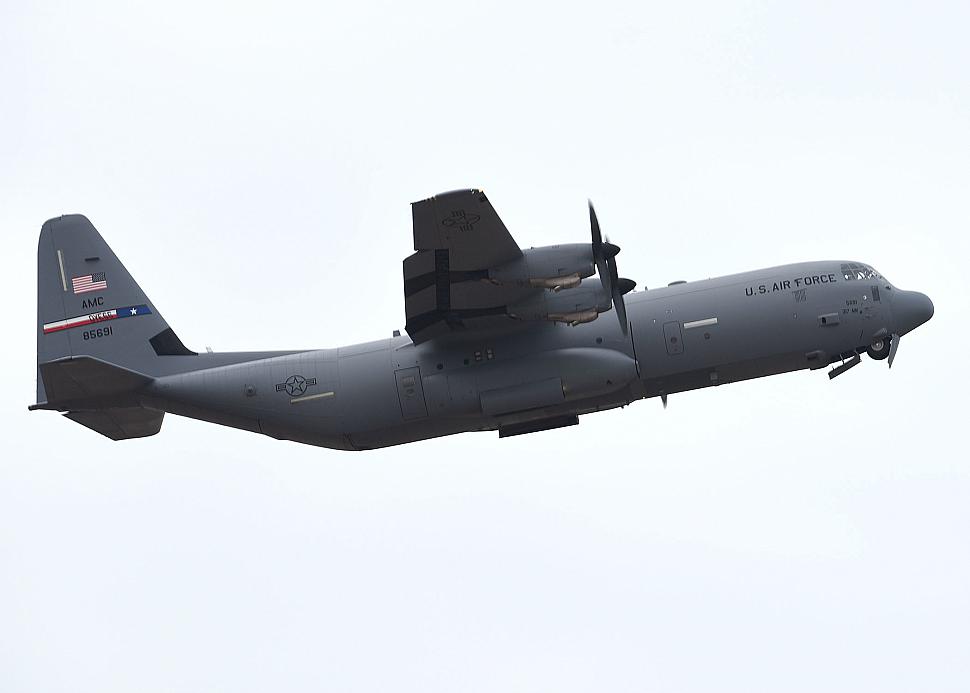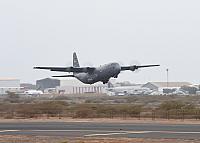C-130 News
C-130 Hercules News
Homestation, deployed locations swap iron to keep C-130Js mission ready
April 17, 2019 (by
A1C Mercedes Porter) -
Wheels hit hot pavement before slowly coming to a halt along a flightline. Humidity and heat waft over busy Airmen as a ramp opens and they are greeted with forklifts. As quick as they landed, the cargo is offloaded within minutes and the C-130J Super Hercules is ready to leave.

This describes the typical day for Airmen in Camp Lemonnier, Africa, when it comes to C-130J missions in deployed locations. Airmen then undergo extreme weather conditions while ensuring their mission is completed.
The C-130J fleet plays a critical role on a global scale. Missions can include transporting service members to combat locations, delivering cargo to Airmen at various deployed sites or to severe weather victims in dire need of resources, and also safely bring home wounded service members for medical care in the U.S. This aircraft is not only built for battle, but also for humanitarian needs around the globe.
In deployed locations such as Camp Lemonnier, Airmen work hard to keep the aircraft mission ready with their available resources and equipment. There are some maintenance requirements, however, that are so resource-heavy and time-consuming that the aircraft needs to return to homestation.
One inspection for which the Super Hercules returns to homestation is called an isochronal (ISO) inspection, which can help maximize the lifespan of the aircraft.
"Without having the required ISO inspections, the C-130Js would not be able to fly and would halt our missions here at Camp Lemonnier," said Senior Airman Nichole Worthing, C-130J Super Hercules crew chief assigned to the 75th Expeditionary Airlift Squadron in Camp Lemonnier, Africa. "We are capable of maintaining our aircraft for crews to fly safely, but we do not hold the capability or equipment to perform such major ISO inspections."
During this comprehensive inspection, the plane is taken apart to inspect each piece. It is imperative that aircraft are inspected this closely for damages, faults or any other problem in every system and part of the aircraft. Inspection time frames vary depending on the individual maintenance needed of the aircraft as discovered during the process.
In order to keep missions going in deployed environments, the aircraft in need of ISO inspections are exchanged in what’s called an “iron swap”.
"An iron swap is when we take a C-130J that has been inspected at our homestation that is up to standards on its maintenance requirements to a deployed location in need of swapping out a C-130J nearing its inspection due date," said Capt. Brian Tignor, C-130J Super Hercules instructor pilot assigned to the 75th Expeditionary Airlift Squadron in Camp Lemonnier, Africa.
With the C-130Js consistently being exchanged during the iron swaps, the Airmen at Camp Lemonnier are able to successfully complete their missions while the Super Hercules can remain well maintained and ready

A C-130J Super Hercules takes off at Camp Lemonnier, Africa, March 14, 2019. The C-130J is used in many operations at Camp Lemonnier to transport cargo and military members to locations throughout East Africa. (U.S. Air Force photo by Airman 1st Class Mercedes Porter)
The C-130J fleet plays a critical role on a global scale. Missions can include transporting service members to combat locations, delivering cargo to Airmen at various deployed sites or to severe weather victims in dire need of resources, and also safely bring home wounded service members for medical care in the U.S. This aircraft is not only built for battle, but also for humanitarian needs around the globe.
In deployed locations such as Camp Lemonnier, Airmen work hard to keep the aircraft mission ready with their available resources and equipment. There are some maintenance requirements, however, that are so resource-heavy and time-consuming that the aircraft needs to return to homestation.
One inspection for which the Super Hercules returns to homestation is called an isochronal (ISO) inspection, which can help maximize the lifespan of the aircraft.
"Without having the required ISO inspections, the C-130Js would not be able to fly and would halt our missions here at Camp Lemonnier," said Senior Airman Nichole Worthing, C-130J Super Hercules crew chief assigned to the 75th Expeditionary Airlift Squadron in Camp Lemonnier, Africa. "We are capable of maintaining our aircraft for crews to fly safely, but we do not hold the capability or equipment to perform such major ISO inspections."
During this comprehensive inspection, the plane is taken apart to inspect each piece. It is imperative that aircraft are inspected this closely for damages, faults or any other problem in every system and part of the aircraft. Inspection time frames vary depending on the individual maintenance needed of the aircraft as discovered during the process.
In order to keep missions going in deployed environments, the aircraft in need of ISO inspections are exchanged in what’s called an “iron swap”.
"An iron swap is when we take a C-130J that has been inspected at our homestation that is up to standards on its maintenance requirements to a deployed location in need of swapping out a C-130J nearing its inspection due date," said Capt. Brian Tignor, C-130J Super Hercules instructor pilot assigned to the 75th Expeditionary Airlift Squadron in Camp Lemonnier, Africa.
With the C-130Js consistently being exchanged during the iron swaps, the Airmen at Camp Lemonnier are able to successfully complete their missions while the Super Hercules can remain well maintained and ready
Courtesy of 7th Bomb Wing Public Affairs
Related articles:
Forum discussion:
Tags
Forum discussion:
- Start a discussion about this article in the C-130.net forum.
Tags

